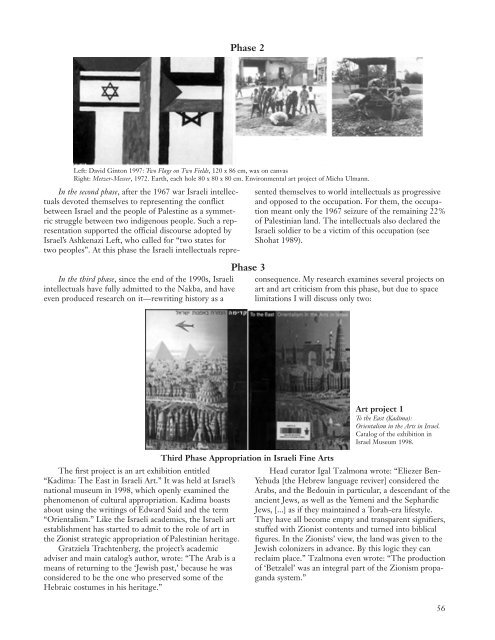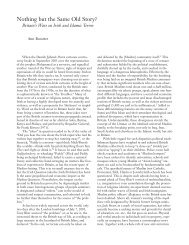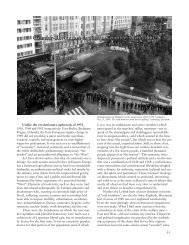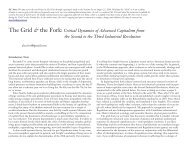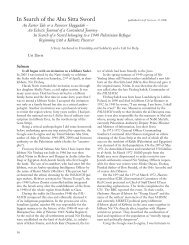Theft of the Nakba Narrative - Left Curve
Theft of the Nakba Narrative - Left Curve
Theft of the Nakba Narrative - Left Curve
You also want an ePaper? Increase the reach of your titles
YUMPU automatically turns print PDFs into web optimized ePapers that Google loves.
The first project is an art exhibition entitled<br />
“Kadima: The East in Israeli Art.” It was held at Israel’s<br />
national museum in 1998, which openly examined <strong>the</strong><br />
phenomenon <strong>of</strong> cultural appropriation. Kadima boasts<br />
about using <strong>the</strong> writings <strong>of</strong> Edward Said and <strong>the</strong> term<br />
“Orientalism.” Like <strong>the</strong> Israeli academics, <strong>the</strong> Israeli art<br />
establishment has started to admit to <strong>the</strong> role <strong>of</strong> art in<br />
<strong>the</strong> Zionist strategic appropriation <strong>of</strong> Palestinian heritage.<br />
Gratziela Trachtenberg, <strong>the</strong> project’s academic<br />
adviser and main catalog’s author, wrote: “The Arab is a<br />
means <strong>of</strong> returning to <strong>the</strong> ‘Jewish past,’ because he was<br />
considered to be <strong>the</strong> one who preserved some <strong>of</strong> <strong>the</strong><br />
Hebraic costumes in his heritage.”<br />
Phase 2<br />
<strong>Left</strong>: David Ginton 1997: Two Flags on Two Fields, 120 x 86 cm, wax on canvas<br />
Right: Metzer-Messer, 1972. Earth, each hole 80 x 80 x 80 cm. Environmental art project <strong>of</strong> Micha Ulmann.<br />
In <strong>the</strong> second phase, after <strong>the</strong> 1967 war Israeli intellectuals<br />
devoted <strong>the</strong>mselves to representing <strong>the</strong> conflict<br />
between Israel and <strong>the</strong> people <strong>of</strong> Palestine as a symmetric<br />
struggle between two indigenous people. Such a representation<br />
supported <strong>the</strong> <strong>of</strong>ficial discourse adopted by<br />
Israel’s Ashkenazi <strong>Left</strong>, who called for “two states for<br />
two peoples”. At this phase <strong>the</strong> Israeli intellectuals repre-<br />
In <strong>the</strong> third phase, since <strong>the</strong> end <strong>of</strong> <strong>the</strong> 1990s, Israeli<br />
intellectuals have fully admitted to <strong>the</strong> <strong>Nakba</strong>, and have<br />
even produced research on it—rewriting history as a<br />
Phase 3<br />
Third Phase Appropriation in Israeli Fine Arts<br />
sented <strong>the</strong>mselves to world intellectuals as progressive<br />
and opposed to <strong>the</strong> occupation. For <strong>the</strong>m, <strong>the</strong> occupation<br />
meant only <strong>the</strong> 1967 seizure <strong>of</strong> <strong>the</strong> remaining 22%<br />
<strong>of</strong> Palestinian land. The intellectuals also declared <strong>the</strong><br />
Israeli soldier to be a victim <strong>of</strong> this occupation (see<br />
Shohat 1989).<br />
consequence. My research examines several projects on<br />
art and art criticism from this phase, but due to space<br />
limitations I will discuss only two:<br />
Art project 1<br />
To <strong>the</strong> East (Kadima):<br />
Orientalism in <strong>the</strong> Arts in Israel.<br />
Catalog <strong>of</strong> <strong>the</strong> exhibition in<br />
Israel Museum 1998.<br />
Head curator Igal Tzalmona wrote: “Eliezer Ben-<br />
Yehuda [<strong>the</strong> Hebrew language reviver] considered <strong>the</strong><br />
Arabs, and <strong>the</strong> Bedouin in particular, a descendant <strong>of</strong> <strong>the</strong><br />
ancient Jews, as well as <strong>the</strong> Yemeni and <strong>the</strong> Sephardic<br />
Jews, [...] as if <strong>the</strong>y maintained a Torah-era lifestyle.<br />
They have all become empty and transparent signifiers,<br />
stuffed with Zionist contents and turned into biblical<br />
figures. In <strong>the</strong> Zionists’ view, <strong>the</strong> land was given to <strong>the</strong><br />
Jewish colonizers in advance. By this logic <strong>the</strong>y can<br />
reclaim place.” Tzalmona even wrote: “The production<br />
<strong>of</strong> ‘Betzalel’ was an integral part <strong>of</strong> <strong>the</strong> Zionism propaganda<br />
system.”<br />
56


